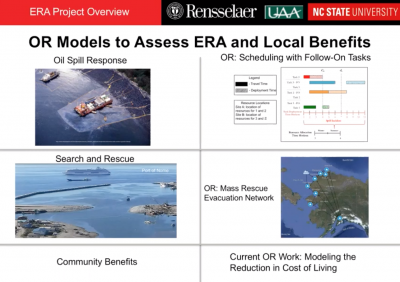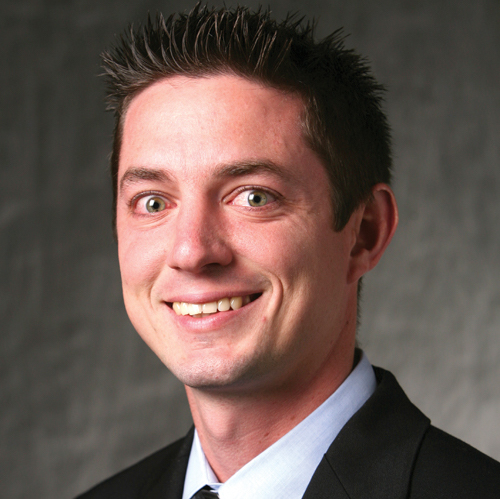Project Abstract
 The Arctic has been experiencing significantly longer ice-free, navigable maritime seasons, thereby changing the types of activities taking place in Arctic waters. Cruise ships are travelling through the Northwest Passage, oil exploration is occurring off the North Slope of Alaska, and the Northern Sea Route is seeing an increasing volume of cargo ships travelling through it. In Arctic Alaska, these tourism and industrial activities will occur far away from the infrastructure and resources of urban and industrial centers, limiting response capabilities when an emergency occurs in Arctic waters. For all of these reasons, there is a critical need to improve Emergency Response in the Arctic (ERA) to meet the increase in the demand for these capabilities. The scientific contribution of this research is to create prescriptive decision-making models that help to determine where, when, and how to make infrastructure investments to improve global ERA capabilities while also providing benefits to Arctic communities. Because the infrastructure required to improve ERA will be built and maintained in local Arctic communities, this project will involve Arctic stakeholders, including representatives from Indigenous communities, to guide the research and help disseminate its results. This project contributes to the NSF's Big Idea on Navigating the New Arctic by: (1) safeguarding human and environmental welfare in increasing ERA capabilities, and (2) working closely with local and Indigenous populations to co-produce knowledge about the types of benefits potentially provided to communities should ERA infrastructure be located in them. Potential benefits include local management of ERA infrastructure and deployment of resources, training and workforce development opportunities, and improved transportation infrastructure.
The Arctic has been experiencing significantly longer ice-free, navigable maritime seasons, thereby changing the types of activities taking place in Arctic waters. Cruise ships are travelling through the Northwest Passage, oil exploration is occurring off the North Slope of Alaska, and the Northern Sea Route is seeing an increasing volume of cargo ships travelling through it. In Arctic Alaska, these tourism and industrial activities will occur far away from the infrastructure and resources of urban and industrial centers, limiting response capabilities when an emergency occurs in Arctic waters. For all of these reasons, there is a critical need to improve Emergency Response in the Arctic (ERA) to meet the increase in the demand for these capabilities. The scientific contribution of this research is to create prescriptive decision-making models that help to determine where, when, and how to make infrastructure investments to improve global ERA capabilities while also providing benefits to Arctic communities. Because the infrastructure required to improve ERA will be built and maintained in local Arctic communities, this project will involve Arctic stakeholders, including representatives from Indigenous communities, to guide the research and help disseminate its results. This project contributes to the NSF's Big Idea on Navigating the New Arctic by: (1) safeguarding human and environmental welfare in increasing ERA capabilities, and (2) working closely with local and Indigenous populations to co-produce knowledge about the types of benefits potentially provided to communities should ERA infrastructure be located in them. Potential benefits include local management of ERA infrastructure and deployment of resources, training and workforce development opportunities, and improved transportation infrastructure.
This research will create new Operations Research (OR) models that not only account for where and when to make infrastructure investments to improve ERA capabilities but how to properly integrate these investments into the communities where they are located. To accomplish this, this project is creating an innovative methodology where social science research done in conjunction with local Arctic communities is conducted in a way that informs the creation of the OR models and, in later stages of the work, validates their results. Therefore, this research integrates methods across OR and social science that link economic, social, cultural, and technical feasibility and desirability by incorporating expert local knowledge into the planning process. The results of this research will transform our understanding of how to design ERA systems that have positive impacts in the local communities where the supporting infrastructure is built and maintained.
Logistics Summary
The objective of this collaborative research between Sharkey (1825712, LEAD, Rensselaer Polytechnic), Lowe (1825490, UAA) and Birkland (1825486, NCSU) is to create prescriptive models that help to determine where, when, and how to make infrastructure investments in the Arctic that both improve global emergency response (ER) capabilities and provide benefits, as identified through local knowledge, to Arctic communities. This project will hold two advisory board meetings, with the first advisory committee meeting held in March 2019 in Anchorage, Alaska. The advisory committee helped to understand and shape the scope of research in Arctic communities and establish contacts within these communities. Beginning in 2019 a field team of three will travel to at least three Arctic communities: Utqiaġvik, Kotzebue, and Nome during the course of the project (researchers will visit these communities twice—once during the information-gathering phase and once during the feedback phase). Researchers will meet with people in borough and/or city government (including risk managers and emergency response officials), Native corporations, and Indigenous community groups to identify options that would both improve emergency response capabilities and benefit the Arctic communities. Researchers also will begin collecting and examining data on the perceived level of emergency response capacity within these Arctic communities and the community’s perceived risk of a large-scale maritime accident occurring in Arctic waters.
Season Field Site
2019 Alaska - Anchorage
2019 Alaska - Kotzebue
2019 Alaska - Nome
2019 Alaska - Utqiaġvik (Barrow)
2020 Alaska - Kotzebue
2020 Alaska - Nome
2020 Alaska - Utqiaġvik (Barrow)
2021 Alaska - Kotzebue
2021 Alaska - Nome
2021 Alaska - Utqiaġvik (Barrow)
Keywords
Oil Spill Response, Search and Rescue, Mass Rescue, Governance, Infrastructure Planning,
Community-Based Participatory Research
Project Location
Dates
-Location
Nome, AK; Utqiaġvik, AK; Kotzebue, AK; Coastal AKMembers
Principal Investigator

Principal Investigator

Principal Investigator

Co-Principal Investigator

Co-Principal Investigator

Collaborator

